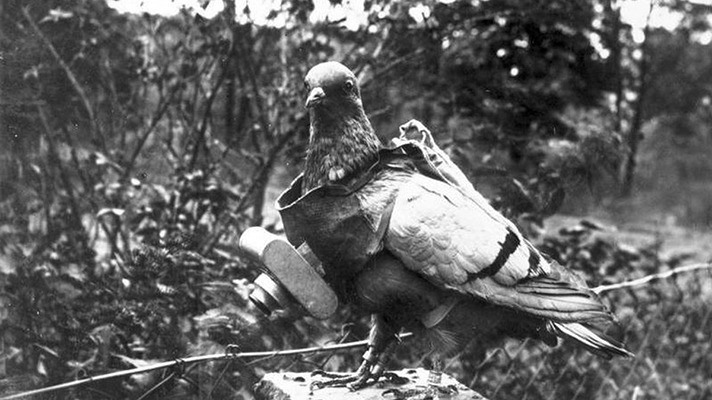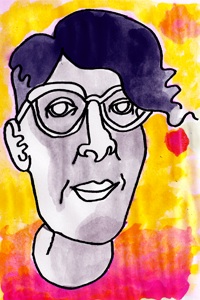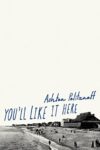
Walking by German scientist Julius Neubronner’s house in Kronberg im Taunus on a sunny Sunday morning, sometime during the first decade of the 1900s, we might run into a small crowd of curious, noses pointing up toward the sky, eyes following the flight of a couple of pigeons fitted with small automated cameras. The crowd would slowly gather around Neubronner himself, welcoming the animals back and freeing them from their harnesses before running off to print the negatives. Back then, aerial photography was a big deal. The new viewing perspective turned large stretches of land into separate images, encoding miniaturized territories and opening up a radically different vista of reality. Everybody wanted to know what things looked like from up above, all the more if the photographer was a pigeon.
The invention of pigeon photography integrated two of Neubronner’s disparate passions: amateur photography and homing pigeons. The German scientist fitted members of his flock with light aluminium harnesses attached to portable cameras. To activate the mechanism in the machines, one would first inflate a small air chamber that, by deflating over the course of the bird’s flight, moved a piston triggering an aperture and then a small shutter. The process sounds clunky, but the equipment was agile and the animals trained to carry proportionate weight. Gliding in the sky, the photographer pigeon would take accidental pictures of built landscape and countryside alike.
The inventor suggested the use of different types of cameras, most of which could take just one picture at a time. A more sophisticated kind had two lenses, one pointing forward and the other one backward, timely operated by the same shutter to take a double-shot in one go. Once pieced back together, the twin photos would compose an expanded panorama with a broader view over the underlying land.
Our perception of the sky, now a favourite observation point to collect and distribute information, has radically changed over the last century. Also our capacity to punctually extract the piece of information we need — and just that — has improved, but perhaps not the intention to do so. If we wanted to track a genealogy of control, the windy routes of Neubronner’s photographer pigeons may deserve a little recognition.

Silvia Mollicchi is a writer and a founding editor of Fungiculture, and is currently based in London. She writes a column for Full Stop about unlikely experiments, inventions and theories.
We can assume with some confidence that several elements had to be savvily primed in this photographic technology, for every single shot was the result of the concerted action of multiple forces. In other words, the camera machine ought to be automated, but according to an exceptional number of parameters: a pigeon’s capacity to orient in space, the weather and the occasional odd cloud, the timing of the piston, the dimensions of the air chamber and the intensity of inflation, the weight of the camera; and then the bird’s hunger and thirst, its instinct to follow recognizable landmarks and fly over the shortest possible track. From a strictly technological perspective, Neubronner’s invention was a poorly concretized machine: virtually every instance of use needed an ad-hoc calibration.
If taking a picture is a composite set of actions that involves choosing a subject, pointing a camera, and shooting, here the agency is spread among maximally disconnected intentions. Expectedly, then, the responsibility for shooting is also scattered across an ecology of agents. And right in the middle of this bizarre configuration, the oblivious pigeon flies back home, taking a picture it does not know it is taking, of a landscape it does not care about, and that, considering the remarkable differences between human and pigeon vision, it has never even seen.
There is more to it, though. The intentions of the many parts involved in the operation are so disconnected that catching useful visual material is tantamount to an epiphenomenon or a side effect. Just sometimes, and incidentally, the information recorded in the pictures would be meaningful for military strategy. And it is at this point that the crowd of curious outside Neubronner’s house becomes far closer to us in time than what we initially thought.
While monitoring tools have radically transformed over the past seven decades — from WWII and the invention of cybernetics — the logic of indetermination that produced them has steadily remained the same.
In Cybernetic Rationality, Orit Halpern writes:
Cyberneticians, within 10 years from the war, moved from working on anti-aircraft prediction to building systems without clear end-points or goals, and embracing an epistemology without final objectives, or perhaps objectivity.
Halpern produces a significant link in her writing. The dismissal of ontology as referent to an external reality, in the first half of the 20th century, nourished two tendencies. On one hand, the post-structural impossibility of perfect translation generated hope for complex relations, pockets of freedom and inventive dimensions. On the other hand, we find cybernetics and then the frenzy for digital multimedia visualization. Since its beginning, cybernetics has been based on incompleteness and lack of information, so that perception and cognition could be trained via patterns to quantify, predict, and then manipulate. Not knowing becomes much better than knowing, as we make room for producing self-referential realities.
Switching to a preemptive mode of control means to literally empty the possibilities for something to happen, when we do not know exactly what that something could be. An epistemology that lacks specific end goals guarantees significant capacity for manipulation, and we constantly see this, manifested in its full force: vast amounts of private information collected and stored for no reason, massive visualization efforts of recombined data, decade-long wars waged against infamous ‘unknown unknowns’. Speculative effects activate the cogs of their own actual realization, in a loopy temporality that swaps the order of causes and consequences. In all this, monitoring devices and visualization are key elements.
Neubronner’s pigeons have never been as pervasive a monitoring device, rather the opposite. Control perhaps, but more mechanic, more poetic. Flocks would take off with a relatively precise aim — a remarkable area to shoot — and then sometimes lose it along the way. The flying route itself constitutes the factor of indetermination that, stitched to the portable camera, turns a technique for aerial photography into an entirely different type of device. Just like anything else in the birds’ photographic practice, control was a glitch. Remotely programmed paths dissolve in the indecipherable geometries of instinctual flight, a diversion, a bit of gliding at low altitude across some enclosed estate. The capacity for random image-making reduces the number of places to hide: no more surprise effect on the military fields — fine! — but also no more unlicensed bargain stalls on side streets, youth crossing fences into private fields, bathing in secret ponds, illicit lovers kissing on sunny roofs. Freedom of natural flight, fetish of the unknown.
1. A similar thing happened during the Second World War. Pigeons and mobile dovecotes were largely utilized to transmit messages and mini-packages, but there is no evidence of the deployment of the special photography squads. In the 1970s, the CIA worked on a similar technology. If details on the type of camera utilized and purposes of application are classified, what nobody made a mystery of is that the testing was an unmitigated disaster.
This post may contain affiliate links.







